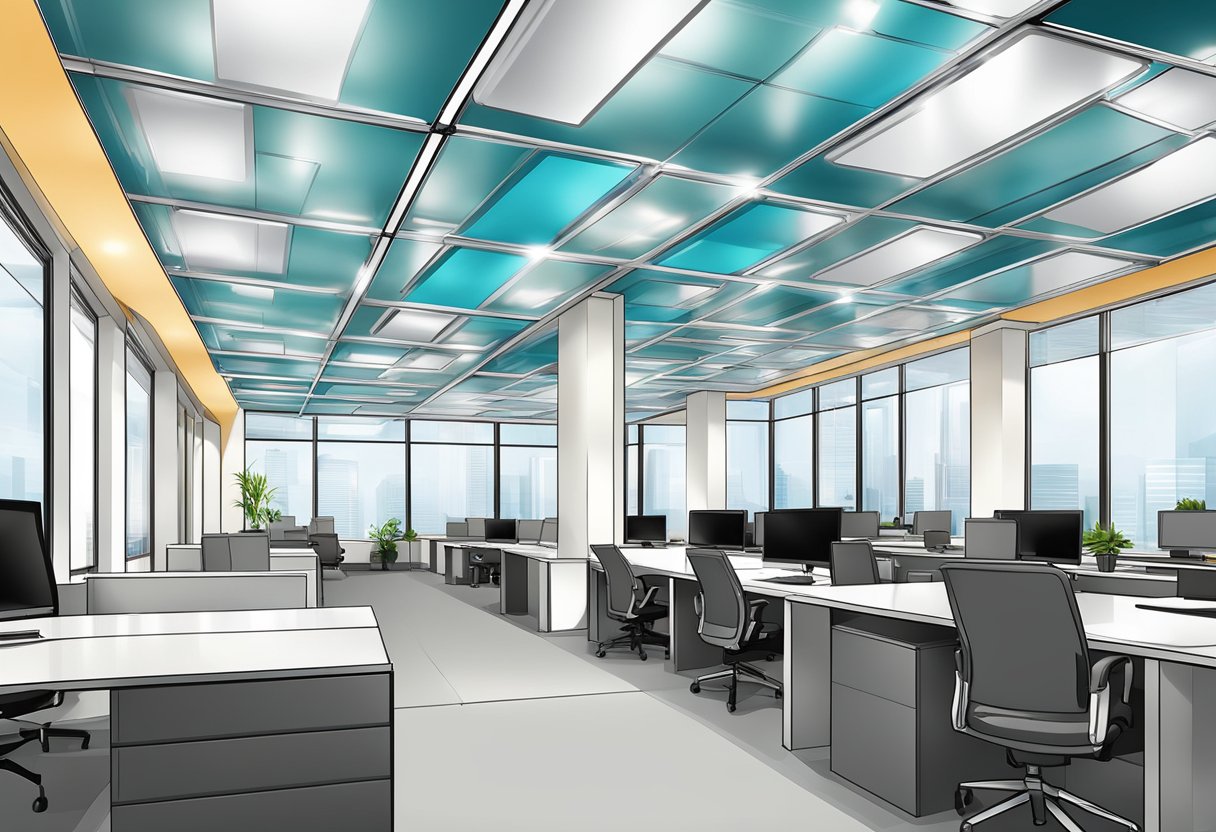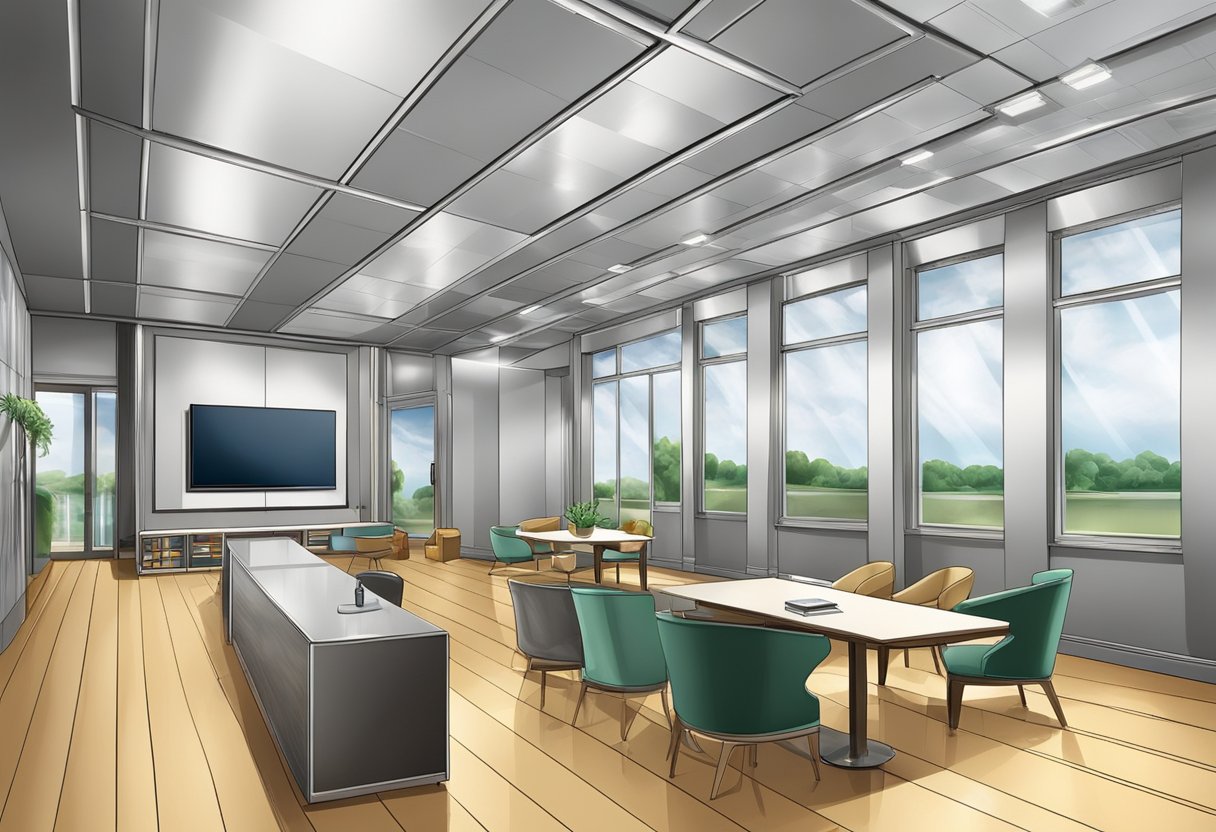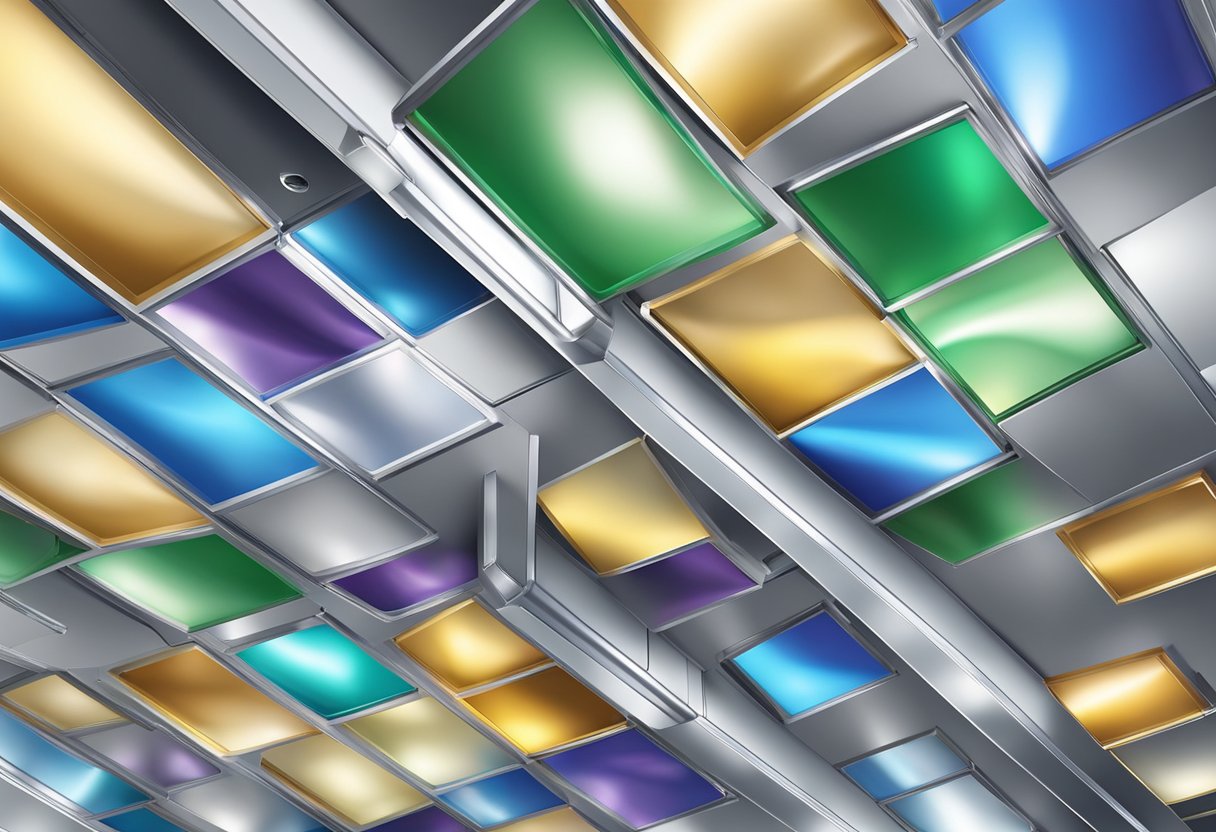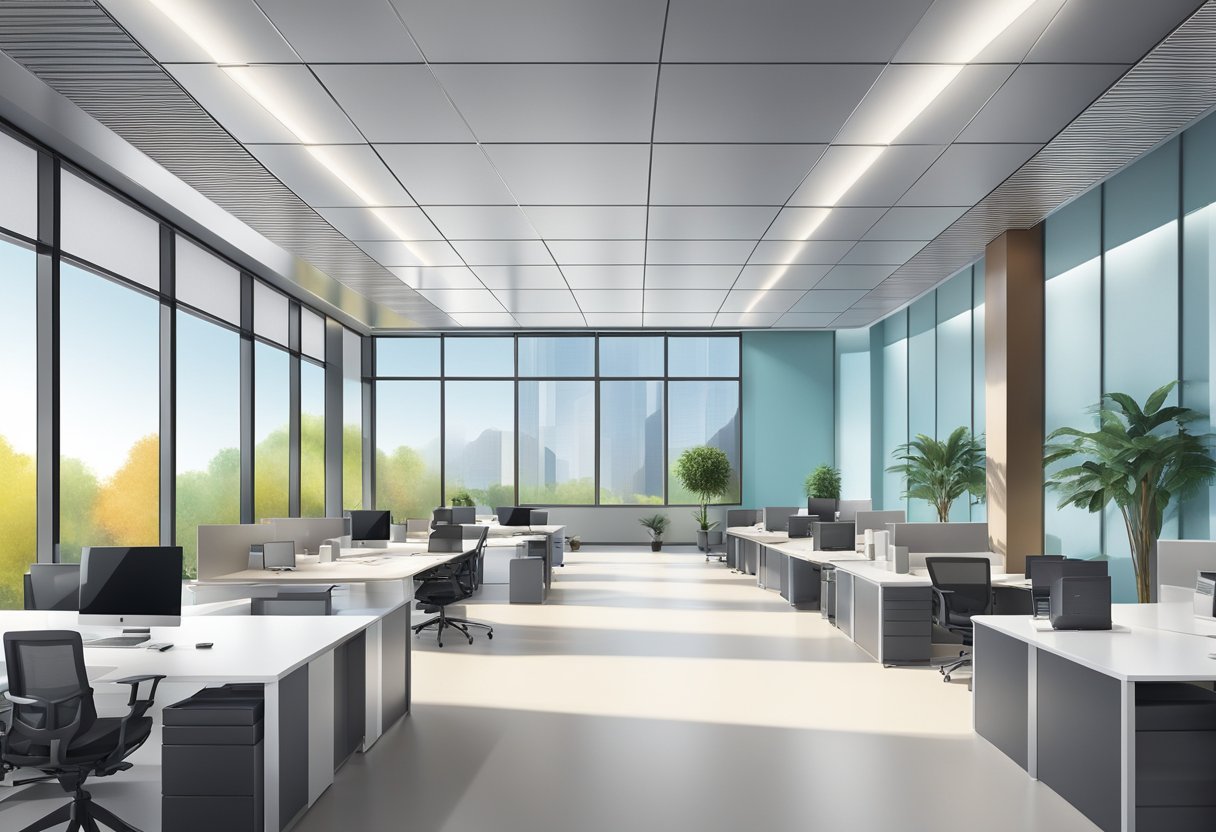Aluminum panel ceiling is a popular choice for commercial and residential buildings due to its durability, versatility, and aesthetic appeal. The use of aluminum panels in ceiling construction has been on the rise in recent years due to its many benefits and advantages over traditional ceiling materials.

One of the main advantages of aluminum panel ceiling is its durability. Aluminum is a strong and long-lasting material that can withstand harsh weather conditions and resist corrosion. This makes it an ideal choice for buildings in areas with extreme weather conditions or high humidity.
In addition to its durability, aluminum panel ceiling is also versatile in terms of design and customization. It can be easily shaped and cut to fit any size or shape of ceiling, and it can be painted or coated in a variety of colors and finishes to match any interior design style. This flexibility makes it a popular choice for architects and designers who want to create unique and visually appealing spaces.
History of Aluminum Panel Ceilings

Aluminum panel ceilings have been in use for over a century. The first aluminum ceilings were introduced in the late 1800s and early 1900s, and were primarily used in commercial buildings such as banks, hotels, and department stores. These ceilings were made from stamped aluminum panels that were designed to mimic the look of more expensive materials such as plaster.
During the mid-20th century, aluminum panel ceilings became more popular in residential construction due to their durability and low maintenance requirements. They were also used extensively in industrial and institutional buildings due to their fire-resistant properties.
In recent years, aluminum panel ceilings have become even more popular due to their versatility and aesthetic appeal. They are available in a wide range of colors and finishes, and can be customized to fit virtually any design scheme. Additionally, they are lightweight and easy to install, making them a popular choice for both new construction and renovation projects.
Overall, the history of aluminum panel ceilings is one of innovation and evolution. From their humble beginnings as a cost-effective alternative to more expensive building materials, they have evolved into a versatile and durable option that is widely used in commercial, residential, and institutional settings.
Types of Aluminum Panel Ceilings

Lay-In Aluminum Panel Ceilings
Lay-in aluminum panel ceilings are a popular choice for commercial and residential buildings. They are easy to install and remove, making them a convenient option for maintenance and repairs. The panels are designed to lay into a standard ceiling grid, creating a smooth and uniform appearance. Lay-in aluminum panel ceilings are available in a variety of colors and finishes, including wood grain, metallic, and matte.
Clip-In Aluminum Panel Ceilings
Clip-in aluminum panel ceilings are another option for those looking for a sleek and modern ceiling design. These panels are designed to clip into an existing grid system, creating a seamless and flush appearance. Clip-in aluminum panel ceilings are available in a range of sizes and finishes, including perforated and non-perforated options. Their clean lines and minimalist design make them a popular choice for contemporary spaces.
Grid Aluminum Panel Ceilings
Grid aluminum panel ceilings are a versatile option for both commercial and residential buildings. These panels are designed to fit into a standard grid system, but they can also be customized to fit non-standard grid patterns. Grid aluminum panel ceilings are available in a range of finishes, including wood grain, metallic, and matte. They are also available in different sizes and shapes, making them a flexible option for different design needs.
In summary, aluminum panel ceilings are a durable and stylish option for those looking to upgrade their ceiling design. With a range of options to choose from, including lay-in, clip-in, and grid systems, there is a solution for every space.
Benefits of Aluminum Panel Ceilings

Durability
Aluminum panel ceilings are known for their durability. They are resistant to moisture, corrosion, and rust, making them ideal for use in humid environments. Additionally, they are resistant to impact and wear and tear, ensuring they last for a long time. These ceilings are also easy to maintain and clean, requiring minimal effort to keep them looking new.
Aesthetics
Aluminum panel ceilings are available in a wide range of colors, finishes, and designs, making them a versatile option for any interior design. They can be customized to fit any space, from modern to traditional, and can be used to create a unique look. Additionally, they have a sleek and modern look, adding a touch of elegance to any space.
Fire Resistance
Aluminum panel ceilings are fire-resistant, making them a safe option for any space. They are made of non-combustible materials, reducing the risk of fire spreading in the event of a fire. Additionally, they can withstand high temperatures, ensuring they do not warp or melt.
Overall, aluminum panel ceilings offer a range of benefits, including durability, aesthetics, and fire resistance. They are a reliable and safe option for any space, and their versatility makes them an excellent choice for any interior design.
Installation Process
Tools and Materials
Before starting the installation process, it is important to gather the necessary tools and materials. The following tools are recommended for the installation of aluminum panel ceiling:
- Measuring tape
- Level
- Screwdriver
- Drill
- Safety glasses
- Gloves
The materials required for the installation process include:
- Aluminum panels
- Suspension system
- Screws
- Clips
- Hanger wires
- Anchors
Installation Steps
- Measure the ceiling to determine the number of panels required.
- Install the suspension system, which includes the main runners, cross tees, and hanger wires.
- Attach the clips to the suspension system.
- Install the aluminum panels into the clips.
- Secure the panels with screws.
- Repeat steps 4 and 5 until all panels are installed.
Safety Measures
During the installation process, it is important to take safety measures to prevent accidents. The following safety measures are recommended:
- Wear safety glasses and gloves to protect eyes and hands from debris and sharp edges.
- Use a ladder or scaffolding to reach high areas.
- Ensure the suspension system is securely fastened to the ceiling.
- Do not overload the ceiling with excessive weight.
By following these installation steps and safety measures, the installation of an aluminum panel ceiling can be completed with ease and efficiency.
Design Considerations
When considering aluminum panel ceilings for a project, there are several design factors to take into account. These considerations include architectural compatibility, acoustic properties, and lighting integration.
Architectural Compatibility
Aluminum panel ceilings come in a variety of finishes and colors, making them a versatile option for most architectural styles. It is important to choose a finish and color that complements the overall design of the space. Additionally, the size and shape of the panels should be chosen to fit the scale of the room.
Acoustic Properties
In addition to their aesthetic appeal, aluminum panel ceilings can also provide acoustic benefits. The panels can be perforated or have sound-absorbing backing to help reduce noise levels in a space. When selecting panels for their acoustic properties, it is important to consider the specific needs of the room and the desired level of sound absorption.
Lighting Integration
Aluminum panel ceilings can be integrated with various types of lighting fixtures, including recessed lighting, pendant lights, and track lighting. When designing a space, it is important to consider the type and placement of lighting fixtures to ensure that they are compatible with the ceiling panels. Additionally, the reflective properties of aluminum panel ceilings can enhance the overall lighting in a space.
Overall, aluminum panel ceilings offer a variety of design considerations that can enhance the aesthetic and functional qualities of a space. By considering factors such as architectural compatibility, acoustic properties, and lighting integration, designers can select the best aluminum panel ceiling for their project.
Maintenance and Care
Cleaning
Aluminum panel ceilings are easy to clean and maintain. Regular cleaning is important to keep the ceiling looking its best and to prevent the buildup of dirt and grime. To clean the ceiling, use a soft, damp cloth or sponge and a mild, non-abrasive cleaning solution. Avoid using abrasive cleaners or scouring pads, as they can scratch the surface of the panels.
It is recommended to clean the ceiling at least once a year, or more frequently if the ceiling is located in a high-traffic area or if there is noticeable dirt buildup. Additionally, it is important to clean the ceiling after any construction or renovation work to remove any dust or debris.
Repair and Replacement
Aluminum panel ceilings are durable and long-lasting, but they may require repair or replacement in the event of damage. If a panel is damaged, it can be removed and replaced with a new panel. Replacement panels are readily available and can be ordered from the manufacturer or supplier.
Minor damage, such as scratches or dents, can often be repaired using a touch-up kit or by applying a small amount of paint or filler. It is important to use a paint or filler that is specifically designed for use on aluminum surfaces.
If the ceiling is damaged due to water or moisture, it is important to identify and address the source of the problem before replacing any panels. Failure to address the underlying issue can result in continued damage to the ceiling.
Regular maintenance and care of aluminum panel ceilings can help to extend their lifespan and keep them looking their best. By following these simple tips, homeowners and business owners can ensure that their ceilings remain in top condition for years to come.
Sustainability and Recycling
Eco-Friendly Manufacturing
Aluminum panel ceilings are manufactured using eco-friendly methods that reduce the impact on the environment. The manufacturing process involves the use of recycled aluminum, which reduces the amount of energy needed to produce new aluminum. Additionally, the manufacturing process is designed to minimize waste and emissions.
The use of aluminum also reduces the amount of resources needed to manufacture the panels. Aluminum is a lightweight material that requires less energy to transport. This reduces the carbon footprint associated with the transportation of the panels.
Recyclability of Aluminum
Aluminum panel ceilings are highly recyclable. Aluminum can be recycled indefinitely without losing its quality or strength. This means that the panels can be recycled at the end of their lifespan, reducing the amount of waste that ends up in landfills.
Recycling aluminum also reduces the need for mining and refining new aluminum. Mining and refining aluminum requires a significant amount of energy and resources, which can have a negative impact on the environment. By recycling aluminum, the demand for new aluminum is reduced, which helps to conserve natural resources.
In conclusion, aluminum panel ceilings are a sustainable and eco-friendly option for commercial and residential spaces. The use of recycled aluminum and the recyclability of the panels make them a responsible choice for those who are concerned about the environment.
Cost Analysis
Initial Investment
The initial cost of installing an aluminum panel ceiling may be higher than other ceiling options, such as drywall or plaster. However, the durability and longevity of aluminum panels can make it a cost-effective choice in the long run.
The cost of aluminum panel ceiling installation varies depending on factors such as the size of the room, the complexity of the installation, and the location. On average, the cost of installing an aluminum panel ceiling ranges from $5 to $15 per square foot.
Long-Term Savings
One of the main advantages of aluminum panel ceilings is their durability and resistance to wear and tear. Unlike other ceiling materials that may require frequent repairs or replacements, aluminum panels can last for decades with little maintenance.
Moreover, aluminum panels are energy-efficient and can help reduce heating and cooling costs. The reflective surface of aluminum panels can bounce back heat and light, keeping the room cool in the summer and warm in the winter.
In the long run, the cost savings from reduced maintenance and energy bills can make aluminum panel ceilings a wise investment.
Overall, while the initial cost of aluminum panel ceiling installation may be higher than other options, the durability and long-term savings make it a cost-effective choice for many homeowners and businesses.
Common Applications
Commercial Buildings
Aluminum panel ceiling is a popular choice for commercial buildings due to its durability and flexibility. It is commonly used in office buildings, hospitals, schools, and shopping centers. The panels are available in a variety of sizes, colors, and finishes, making it easy to match the decor of any space. Additionally, aluminum panel ceilings are easy to install and maintain, reducing the overall cost of ownership.
Residential Projects
Aluminum panel ceiling is also a great option for residential projects. It is commonly used in kitchens, living rooms, and bedrooms. The panels are available in a variety of finishes, including wood grain and metallic, allowing homeowners to achieve the desired look for their space. Additionally, aluminum panel ceilings are easy to clean and maintain, making them a practical choice for busy families.
Transport Facilities
Aluminum panel ceiling is an excellent choice for transport facilities, such as airports and train stations. The panels are lightweight and easy to install, making them ideal for large-scale projects. Additionally, aluminum panel ceilings are fire-resistant, which is essential in spaces where safety is a top priority. The panels are also resistant to moisture and humidity, making them a practical choice for spaces with high levels of humidity.
In summary, aluminum panel ceiling is a versatile and practical choice for a variety of applications. Its durability, flexibility, and ease of maintenance make it an excellent option for both commercial and residential projects, as well as transport facilities.
Innovations in Aluminum Panel Ceilings
Smart Technology Integration
Aluminum panel ceilings have come a long way since their inception. With the advancements in technology, smart integration is now possible. Smart technology integration allows for the control of lighting, temperature, and other features through a mobile device or computer. This innovation has made aluminum panel ceilings not just aesthetically pleasing but also functional.
Smart technology integration has allowed for the creation of dynamic lighting systems that can be controlled remotely. Lighting systems can be set to adjust automatically based on the time of day or the amount of natural light in the room. This feature has not only made aluminum panel ceilings energy-efficient but also visually appealing.
Improved Insulation Technologies
Insulation is an essential feature in any ceiling, and aluminum panel ceilings are no exception. With the advancements in insulation technologies, aluminum panel ceilings can now provide better thermal insulation, sound insulation, and fire protection.
The use of high-density insulation materials has made aluminum panel ceilings more energy-efficient and noise-proof. These materials also provide better fire protection, making aluminum panel ceilings a safer option for commercial and residential buildings.
In conclusion, the innovations in aluminum panel ceilings have made them a popular choice for modern buildings. Smart technology integration and improved insulation technologies have made aluminum panel ceilings not just visually appealing but also functional, energy-efficient, and safe.
Regulatory Standards and Compliance
Aluminum panel ceilings are subject to regulatory standards and compliance requirements to ensure safety and quality. These standards are set by various regulatory bodies and organizations, including the International Code Council (ICC), the American Society for Testing and Materials (ASTM), and the Occupational Safety and Health Administration (OSHA).
One of the most important regulatory standards for aluminum panel ceilings is fire safety. Panels must meet specific fire resistance ratings to prevent the spread of flames and smoke in the event of a fire. The ASTM E84 standard measures the surface burning characteristics of building materials and is used to determine the fire resistance of aluminum panel ceilings.
In addition to fire safety, aluminum panel ceilings must also comply with standards for acoustics, ventilation, and moisture resistance. These standards help ensure that the ceiling panels provide a comfortable and healthy indoor environment.
To ensure compliance with these standards, it is important to work with reputable manufacturers and installers who follow industry best practices. This includes proper installation techniques, use of high-quality materials, and adherence to safety standards set by regulatory bodies.
Overall, regulatory standards and compliance play a crucial role in ensuring the safety and quality of aluminum panel ceilings. By following these standards, building owners and occupants can have peace of mind knowing that their ceilings are safe and reliable.
